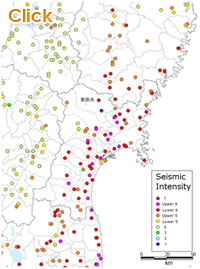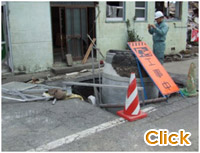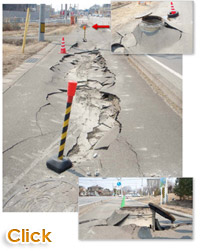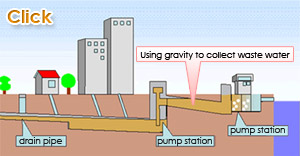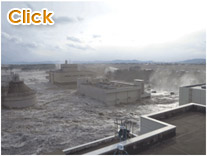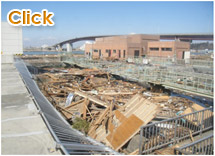Great East Japan Earthquake Strikes Sewerage System
Takeshi Yamauchi
2. Damage in the Sewerage System in Tohoku Area
2.1 Tohoku Earthquake
- Date
- March 11th,2011, 14:46 (JST)
- Magnitude
- 9.0
- Epicenter
- Sanriku coast, about 130km from shore, 24km deep
- Seismic intensity of three prefectures of Tohoku (Japanese scale)(Table 3)
- Iwate prefecture
- 6
- Miyagi prefecture
- 7 in Northern area, 6 in the other
- Fukushima prefecture
- 6
- Heights of Tsunami
- Heights of tsunami in some areas went up to 8 meters and higher, which is almost equal to two stories house.
| City | Highest Wave Observed | Time Observed(Date) | Time Observed(Time) |
|---|---|---|---|
| Soma city(Fukushima) | 9.3m | 3/11 | 15:51 |
| Ishinomaki city(Miyagi) | 8.6m | 3/11 | 15:26 |
| Miyako city(Iwate) | 8.5m | 3/11 | 15:26 |
2.2 Damages of Waste Water Treatment Plants, Pumps, and Pipes
-
Damages of Waste Water Treatment Plants and Pump Station (as of June 30,2011)
Table 3. Number of damaged waste water treatment plants and pump stations Right after the Earthquake As of June 30, 2011 Waste Water Treatment Plants Out of Service 48 16 Damaged 63 40 Pump Station Out of Service 79 25 Damaged 32 46 Out of the 16 plants that are out of service (Table 3), 11 plants are now performing temporary measures, 1 plant is treated at other plants, 2 plants are preparing for temporary measures, 2 areas where no waste water is coming.
- Damage of Pipes(As of June 30, 2011)
Table 4. Length of damaged pipes Total Length of pipes in the prefecture Damaged pipes Ratio of the Damaged pipes Iwate 1,762km 18km 1.0% Miyagi 9,676km 192km 2.0% Fukushima 4,878km 104km 2.1% (6) (Ministry of Land, Infrastructure, Transport and Tourism announced)
Waste Water Treatment Plants that are Out of Service (As of June 28, 2011)
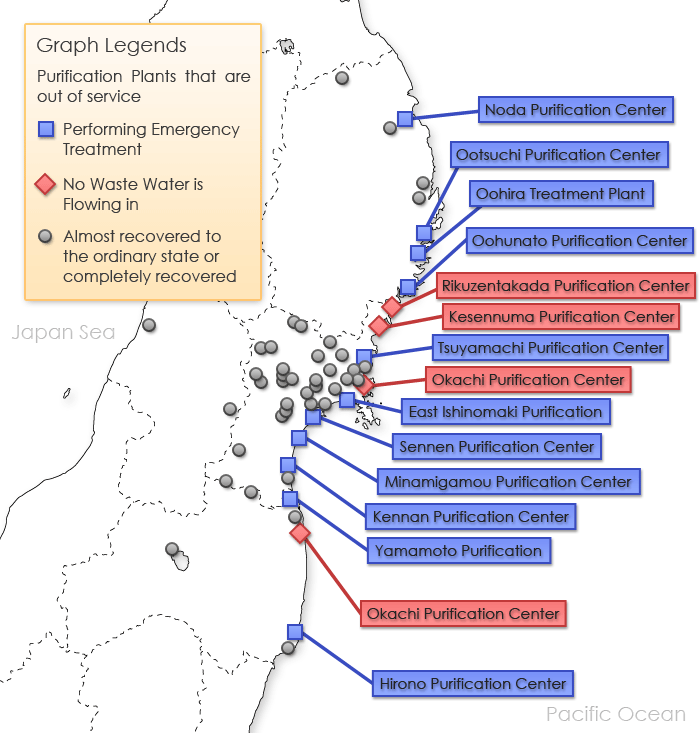
Figure 4. (7)
2.3 Situation of Damaged Sewerage Systems
- a. Pipes
- Manhole upheaval and subsidence of nearby ground stand out in this earthquake.
-
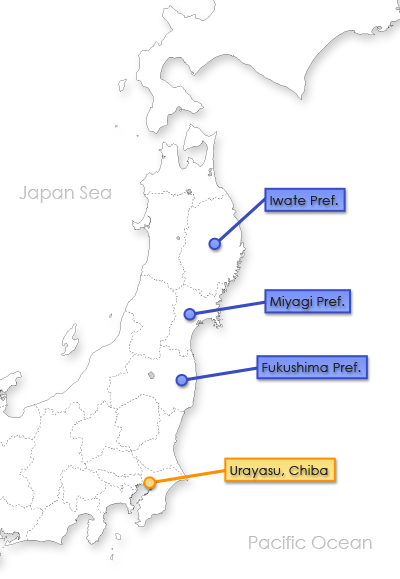
Figure 7. Urayasu, Chiba, which is far from the epicenter, was also suffered from the Great East Japan Earthquake.

Figure 8. Water is coming up from the crack in the road. (12)
This is mainly because of ground movement due to the earthquake. These buried ground become loose by soil liquefaction and cause manholes to rise up. Soil liquefaction occurs when a saturated soil substantially losses strength and stiffness in response to an earthquake shaking or other sudden change in stress condition, causing it to behave like a liquid. (10) This causes buildings with higher density than that of liquefied soil to sink, and buildings with lower density to float. Manholes and pipes have lower density than that of liquefied soil, so they rise up in earthquake. On the other hand, concrete pavement sank in soil liquefaction. It is said that soil liquefaction often occurs area near ocean and river. Soil liquefaction also often occurs in area with reclaimed ground.
Urayasu city, Chiba is also suffering from the Great East Earthquake. In Urayasu city, four-thirds of its land is reclaimed ground, so damage in infrastructure is very big. Infrastructure in Urayasu city is badly damaged, including water work pipes, gas pipes, drain pipes, and etc. More than 10 % of drain pipes were damaged in this earthquake, and the city called on more than 10,000 houses to voluntarily refrain from using sewerage. (11)
Pipes themselves also got damaged in this earthquake. As you can see from the table 4, total of more than 100km of pipes were damaged in Miyagi. However if you look at the ratio of damaged pipes to total pipes, it is only 2%. Pipes that were constructed relatively later before the Tohoku earthquake were not damaged so much because the newly constructed pipes have earthquake-proof structure.(13)
- b. Waste Water Treatment Plants
-
In this earthquake, many waste water treatment plants were severely damaged. This is due to locations of waste water treatment plants. Most waste water treatment plants were constructed near the coastal area because of sewage systems structure. In the sewage system, waste water from cities were collected by drain pipes and sent to waste water treatment plants with the gravitational force. It is likely that waste water treatment plants were located at lower ground level than the cities.
Thus, waste water treatment plants were evidentially located at the coastal area.
Damages of waste water treatment plants were mainly breakage of machines and electrical connections due to the tsunami. Waste water treatment plants located at the coastal area were submerged. Pumps in treatment plants were broken, so plants were not capable of sending raw waste water to treatment process.
Debris from the cities brought in by tsunami has to be cleared up too. Chambers that are used for treatments do not have top, so floating objects could easily come into the chambers.




